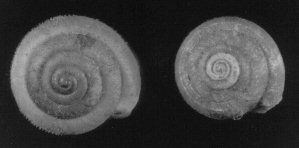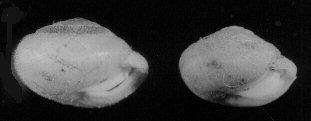| The One That Got Away |
| By Harry G. Lee |
| The name
Charles W. Johnson is a familiar one to many collectors and
students of malacology, particularly those who live and collect
in our neck of the woods. Johnson lived in St. Augustine as a lad
and began his studies of mollusks there. Later he moved to
Philadelphia where he curated several collections and made
contributions in malacology, paleontology, and the study of
dipterous flies. He was an excellent field man, and in 1900 the Philadelphia Academy sent him to his former home state in search of Tertiary fossil material. Johnson collected in the limestone-rich area between the Appalachicola and Chipola Rivers in the Florida Panhandle. He was an inveterate collector, and when the fossil hunting was exhausted, he tried his hand at land snails on several occasions. Near the end of the trip he missed a train connection and was forced to stay over night at Marianna, Florida. Earlier he had noticed a particularly appealing spot on the bank of the Chipola River. He arose quite early on the day of his departure and walked the mile to the river and made a collection. In his report in The Nautilus he described the station as "... an ideal collecting ground; limestone, moisture, varied vegetation, a cave and an old quarry with moss-covered rocks in all directions ... just what the snails want, and visions of a new species or variety formed an active stimulant; for I felt sure that Hemphill, Ferriss, and Sargent had not been there." Johnson had good luck, collecting some fifteen species of land snails including a sinistral specimen of Anguispira alternata.* With his usual careful attention, he noted that one species, Polygyra stenotrema, was a new Florida record. He was nonetheless crestfallen as he went on to say "But alas, while the snails were thick, a nov. sp. was not to be found by 'dis chile'." Exactly forty years later Johnson's former colleague and friend, Henry Pilsbry, described a new species of polygyrid snail from this same interesting part of our state. In reviewing the Philadelphia Academy collection, Pilsbry noted that Johnson's specimen of "P. stenotrema" was in fact not that species but the brand new species, Stenotrema florida, the only member of the genus presently known to occur in Florida. In fact, S. florida is one of a very small group of non-tropical snails which seems to have its center of distribution in our state.
Left: Stenotrema florida (13.1 mm.) from Florida State Caverns (about 2 miles N. of Johnson's station), Jackson Co., Florida. Right: Stenorema stenotrema (11.0 mm.) from Princeton, Jackson County, Alabama. Thus 'dis chile', although some eight years posthumously, achieved the feat of which he stood in great awe, namely finding a new species of land snail. This singular accomplishment is becoming more difficult to duplicate, but many of us harbor secret ambitions along this line, I daresay. Perhaps there's a lesson in Johnson's sadly ironic account. When time allows, pore over your specimens, be they land, freshwater or marine. Sometimes it takes two or three examinations to be sure that there are no extraordinary characteristics that require "follow-up". In case you have reservations about the identity of certain material, seek an expert's help. Remember that most malacologists have special fields of interest and try to find the "best man for the job". Write ahead to obtain permission and confirm your plan to submit specimen(s) for identification and include gratis duplicates (if available) for the worker or his institution. Remember that professional malacologists are busy, but you can be sure if you have a new variety or species, you'll evoke a positive response from most of them in less than two score years. Bibliography: 1. Abbott, R. T. (editor) The Best Of The Nautilus - A Bicentennial Anthology of American Conchology, American Malacologists, Greenville, Delaware, 1976. 2. Pilsbry, H. A. Land Mollusca of North America . . . Vol. 1, part 2, p. 655, Philadelphia, l940. *This species is now known as A. strongylodes (L. Pfeiffer, 1854). Johnson's sinistral specimen is in Philadelphia and was figured in Abbott, R. T., 1989. Compendium of Landshells. American Malacologists, Melbourne, FL, vii + pp. 1-240, P. 125 [as A. alternata (Say, 1817)]. See another sinistral specimen from Marianna, Florida in H. G. Lee's collection. Note: Originally published in the Shell-O-Gram during July, 1976. |


